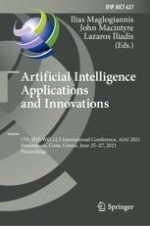This book constitutes the refereed proceedings of the 17th IFIP WG 12.5 International Conference on Artificial Intelligence Applications and Innovations, AIAI 2021, held virtually and in Hersonissos, Crete, Greece, in June 2021.
The 50 full papers and 11 short papers presented were carefully reviewed and selected from 113 submissions. They cover a broad range of topics related to technical, legal, and ethical aspects of artificial intelligence systems and their applications and are organized in the following sections: adaptive modeling/ neuroscience; AI in biomedical applications; AI impacts/ big data; automated machine learning; autonomous agents; clustering; convolutional NN; data mining/ word counts; deep learning; fuzzy modeling; hyperdimensional computing; Internet of Things/ Internet of energy; machine learning; multi-agent systems; natural language; recommendation systems; sentiment analysis; and smart blockchain applications/ cybersecurity.
Chapter “Improving the Flexibility of Production Scheduling in Flat Steel Production Through Standard and AI-based Approaches: Challenges and Perspective” is available open access under a Creative Commons Attribution 4.0 International License via link.springer.com.
